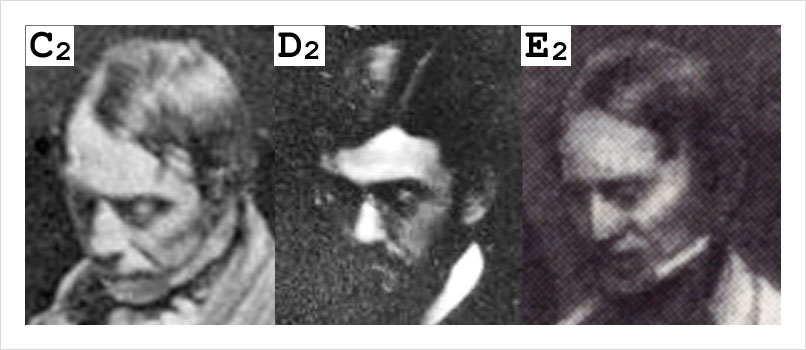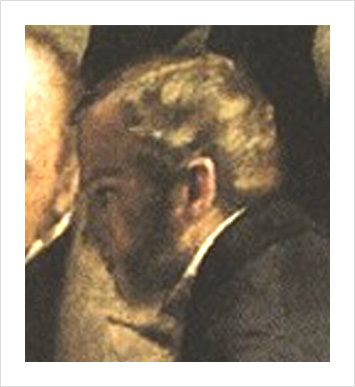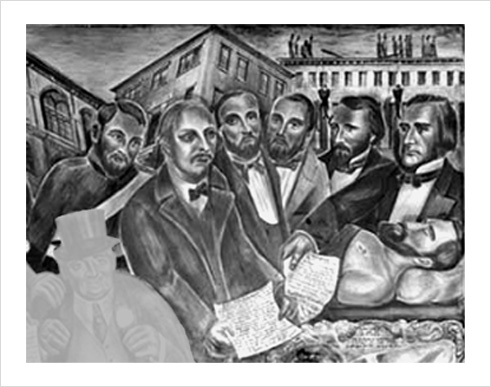

|
Comparative views alleging Bertody: C2.) Detail of the monitoring physician in EDD No. 5. D2.) Detail (reversed) of Figure 1 in the "reenactment" daguerreotype E2.) Detail (reversed) of the white-coated physician in Hall's first-state print of his engraving. |
Deep shadows, paucity of detail, and surface degradation in the area of Figure 1 of the "reenactment" daguerreotype prohibit identifying the doctor with any certainty. Lowry & Lowry believe it is John Call Dalton, but don't say what prompted their view; certainly, the ear would match Dalton's if it were dimensionally smaller.(63) If the daguerreotype represents one of the five possible ether operations that comply with the age, sex, and clinical profile of the patient, then accordingly Figure 1 might be Dalton, Briggs, Bertody, George Parkman, or another doctor on the staff of the hospital. The identities of Dalton and George Parkman were already discussed, and the identity of Briggs will be addressed under the segment covering Jonathan Mason Warren's second surgery.
My attribution naming Bertody is adduced both from Parkman's report covered below, and also the physician who is wearing a light-colored coat and is seen standing between J. Collins Warren and Jacob Bigelow in EDD No. 5. He is the attending physician for the operation and his hand is positioned on the neck of the patient to monitor carotid pulse and blood pressure. I believe this is Bertody and trace evidence supporting this view is found in the first-state print of Hall's portrayal of the Abbott operation, where his features are an unmistakeable match, except he is portrayed wearing a white coat and with his hand pulling free Abbott's collar. Bertody's portrait was expunged from the final-state of Hall's etching that illuminated the Rice book. Refuting my attribution is the fact that Figure 1 is bearded and the monitoring physician in EDD No. 5 is shaven. In Hinckley's painting Bertody is again bearded, but the resemblance is only slight.



|
Image left: representation of the James King of William assassination, painted by Bernard Zakheim for one of his murals in the Toland Hall Medical Pavilion, UCSF Parnassus Campus, San Francisco. King died on May 14, 1856, from sepsis that might have been avoided if a sponge tamponade inserted into the wound had been removed, early into his recovery. Identities of the six principal physicians involved in the controversy over the failure of King's recovery, from left to right: John Strother Griffin (1816-1898), Richard Beverly Cole (1829-1901), Robert Kennedy Nuttall (1815-1881), Charles Bertody (1824-1893), Henry M. Gray (1826-1868), Hugh Hughes Toland (1806-1880). Descriptions are from Zakheim's collaborator, Phyillis Wrightson, published in the 1948 yearbook, "Medi-CAL" (San Francisco: University of California ; vol. 2, p. 96 »»).
|
Not much is known about Bertody. He was appointed House-physician two months prior (August 12), but his tenure at MGH ended when he joined the throngs of forty-niners who turned their dreams westward during the 1849 California Gold Rush. Presumably, he accompanied his Harvard classmate, Washington Ayer (1823-1899), who spent six years digging for gold before returning to medical practice.(64) The two men then settled and practiced medicine in San Francisco, representing Harvard in the pioneer medical associations that were establishing in the city. Bertody was an active member on a number of medical boards and was named Corresponding Secretary of the Second San Francisco Medical Society in 1853. He was one of the physicians consulted when James King of William (1822-1856), editor of the San Francisco Evening Bulletin, was shot. Bertody may or may not have benefited from the political turmoil within the medical community that followed the assassination.
63.) Lowry & Lowry (2005); p. 79.
64.) Ayer was a witness to the Abbott operation and he recounted his experience before a meeting of the San Francisco Medico-Chirurgical Society on February 3, 1895, under the title, "The Discovery of Anesthesia by Ether: With an Account of the First Operation Performed Under Its Influence at the Massachusetts General Hospital, and an Extract from the Record-book of the Hospital" (Sacramento, 1896). Very little of Ayer's memory of the event deviated from what was already in the literature, but regarding the great surgeon's stature he contributed the following, "Dr. Warren was of medium size, perhaps 5 feet 8, and did not weigh more than 150 pounds at that time. He had a great deal of energy and determination in his movements."
